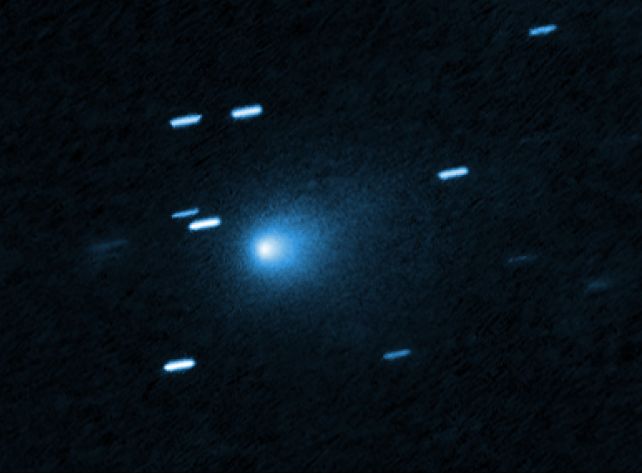Take a deep breath. Reports that interstellar comet 3I/ATLAS is breaking apart have been greatly exaggerated – and radio signals received don't mean the object is an alien probe.
In fact, quite the opposite is true: Every piece of evidence collected about 3I/ATLAS to date is consistent with a natural, cometary origin – a highly weird comet, to be sure, but a comet nevertheless. And, actually, that's really interesting and cool, without needing the assistance of imaginary aliens to make it so.
What is unusual about 3I/ATLAS is what it's made of. Observations with large telescopes reveal that it has a lot of nickel, a larger-than-usual proportion of carbon dioxide, and not a lot of common carbon-chain molecules.
Related: 4 Powerful Telescopes Agree: Interstellar Comet 3I/ATLAS Really Is Bizarre

It's also red and dusty, suggesting it has spent a long time being bathed in cosmic rays as it travels through space. It's traveling very fast, and a preliminary estimate based on early kinematic modeling suggests it could have formed as long as 11 billion years ago.
Taken together, all these oddities combine into a comet unlike anything else in the Solar System, tremendously exciting for planetary scientists and anyone else who likes space – but ever since it was discovered on 1 July 2025, it's been dogged by rumors of alien pilots reconnoitering the Solar System.
These can all be pretty much laid at the feet of one scientist: Harvard astrophysics enfant terrible Avi Loeb, who has hitched his wagon to interstellar objects – first 1I/'Oumuamua, now 3I/ATLAS (2I/Borisov, Loeb agreed, was actually a comet).

Loeb's arguments in favor of the alien probe theory for 3I/ATLAS have been thoroughly rebutted in a blog post by astronomer Jason Wright of Penn State.
It's worth reading through, but Wright concludes succinctly: "of Loeb's 10 anomalies, only 4 really have planetary scientists interested: the high nickel abundance, the extreme polarization, the strange water abundance, and the rapid brightening. All of these are the sorts of anomalies one expects from a new kind of comet."
The claim that 3I/ATLAS may be breaking apart also came from Loeb, who asserted that the amount of material in the comet's tail when it emerged from behind the Sun in early November indicated a mass loss rate too high for a comet of 3I/ATLAS's size to maintain structural integrity.

Actually, comets often break apart when they get near the Sun; sublimating ice erupting from the comet can pop it open like a champagne cork, or increase its spin, exerting centrifugal force that can cause it to fly apart.
If the comet did break apart, that would be proof that it's actually a comet; remaining intact, on the other hand, could mean it's artificial, according to Loeb.
Most other scientists disagree. As cometary scientist Qicheng Zhang of Lowell Observatory in Arizona told LiveScience, "All the images I've seen show a fairly ordinary/healthy-looking comet. There's no sign at all that the nucleus broke apart."
New morphology in the tail of comet 3I/Atlas will inevitably be spun by the quack Avi Loeb as some evidence of alien activity. This is nothing new, we've seen similar behavior in other comes including 17P, C/2016 R2, and C/1961 R1, and others. It's ionized carbon monoxide. #3I #3I/Atlas #Comet 🔭
— David Rankin (@asteroiddave.bsky.social) 2025-11-08T19:24:18.315Z
You may also have heard some buzz about radio signals from the comet. That comes from the MeerKAT radio telescope array in South Africa, which studied the comet on 24 October 2025. On the one hand, this feels like a no-brainer: when you point a radio telescope at something, you're going to get data back in radio wavelengths.
But on the other hand, sure, we can go into what it actually found. When a comet sublimates water ice, ultraviolet light from the Sun can split the water molecules in the vapor into smaller constituents – namely, the hydroxyl radical, OH – a process called photodissociation. This produces radio absorption signals at 1665 MHz and 1667 MHz.
These signatures are what we see in Solar System comets, and precisely what scientists expected to see in 3I/ATLAS as it grew nearer to the Sun – and sure enough, that's just what scientists observed in the MeerKAT observations of our interstellar visitor.
We're still learning about 3I/ATLAS, but so far every datapoint is consistent with a comet – just a really peculiar one.
And, as Canadian astronomer David Levy once pointed out, "Comets are like cats: they have tails, and they do precisely what they want."
Even in the face of overwhelming evidence, you're still going to get a few people insisting their highly unlikely theory is plausible. And there is a lot of value in questioning scientific dogma. In this case, though, there's an overwhelming body of evidence supporting a cometary identity for 3I/ATLAS – and not a lot more than a sputtering "but, but, but" otherwise.
Make no mistake, scientists are going to continue to watch 3I/ATLAS extremely closely as it zooms away out of the Solar System. There may even be an opportunity for Jupiter probe Juno to take close observations when the comet zips past the gas giant in March 2026. That will be tremendously exciting.
3I/ATLAS is a comet that traveled through interstellar space for billions of years to visit us from a whole other star. If that is not enough to impress you on its own, you need to rediscover your sense of wonder. Seriously.

